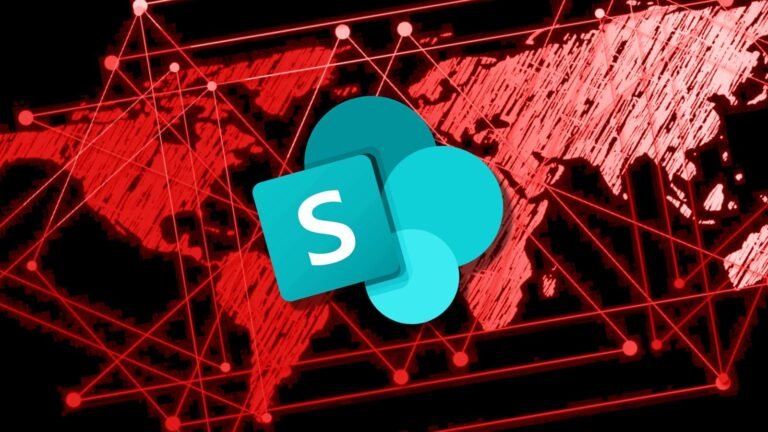Summary Points
-
Ransomware Surge: A new variant called 4L4MD4R, based on open-source code, has emerged as part of ongoing attacks exploiting Microsoft SharePoint vulnerabilities, impacting at least 148 organizations globally.
-
Notable Targets: High-profile compromises include the U.S. National Nuclear Security Administration and various European government networks, with state-sponsored Chinese hacking groups, like Linen Typhoon and Violet Typhoon, linked to the ToolShell exploit.
-
Security Flaws Addressed: Two zero-day vulnerabilities exploited in these attacks—CVE-2025-49706 and CVE-2025-49704—have been patched by Microsoft, which also noted the exploitation of newly identified CVEs (CVE-2025-53770 and CVE-2025-53771) in updated security measures.
- Widespread Infection: The actual scope of the exploitation is believed to surpass initial estimates, with cybersecurity reports indicating that 400 servers across multiple sectors have been infected, prompting urgent action from the Cybersecurity and Infrastructure Security Agency (CISA).
What’s the Problem?
In a significant escalation of cyberattacks, ransomware gangs have exploited a vulnerability chain in Microsoft SharePoint, leading to the compromise of at least 148 organizations globally. Security researchers from Palo Alto Networks’ Unit 42 identified a new ransomware variant, 4L4MD4R, linked to these attacks, which was deployed through a malware loader that activates after a failed exploitation attempt. This ransomware, designed to encrypt files and demand a ransom of 0.005 Bitcoin, demonstrates a sophisticated use of open-source coding, further complicating security defenses as noted by the researchers.
The primary perpetrators behind this campaign are believed to be state-sponsored Chinese hacking groups, specifically identified by Microsoft as Linen Typhoon, Violet Typhoon, and Storm-2603. As federal agencies scramble to patch vulnerabilities exposed in these attacks, which have successfully infiltrated various sectors including national security and public administration, the Cybersecurity and Infrastructure Security Agency (CISA) has mandated immediate action to secure affected systems. This situation reflects a growing frequency and severity of cyber threats targeting critical infrastructure, necessitating heightened vigilance and robust defensive strategies from organizations worldwide.
What’s at Stake?
The recent spate of ransomware attacks exploiting vulnerabilities in Microsoft SharePoint not only jeopardizes the compromised organizations directly but also poses significant risks to an array of interconnected businesses, users, and governmental entities. As ransomware variants like 4L4MD4R proliferate through sophisticated exploit chains, the ripple effects can undermine trust in digital infrastructures, disrupt essential services, and lead to substantial financial losses among partners and clients within affected ecosystems. Organizations that share networks or supply chains with compromised entities may find themselves inadvertently dragged into the maelstrom of data breaches, reduced operational capabilities, and cascading downtimes, amplifying the overall vulnerability of the cyber landscape. Furthermore, the threat posed by state-sponsored actors exacerbates this risk, as their capabilities and motivations enhance the likelihood of sustained, aggressive attacks, creating an environment of uncertainty that compromises the stability of entire sectors reliant on digital collaboration. Consequently, vigilant cybersecurity measures and rapid incident response protocols become paramount to mitigate the broader implications of such incidents.
Possible Actions
The rising frequency of targeted ransomware attacks on Microsoft SharePoint servers underscores the imperative of timely remediation to safeguard sensitive data and maintain operational continuity.
Mitigation Steps
- Regular Backups
- Patch Management
- Network Segmentation
- Access Controls
- Multi-Factor Authentication
- Employee Training
- Incident Response Planning
NIST CSF Guidance
The NIST Cybersecurity Framework (CSF) emphasizes proactive risk management and incident response strategies, aligning with best practices for minimizing vulnerabilities exploited by ransomware. For further details, refer specifically to NIST SP 800-53, which outlines security and privacy controls relevant to this issue.
Continue Your Cyber Journey
Discover cutting-edge developments in Emerging Tech and industry Insights.
Learn more about global cybersecurity standards through the NIST Cybersecurity Framework.
Disclaimer: The information provided may not always be accurate or up to date. Please do your own research, as the cybersecurity landscape evolves rapidly. Intended for secondary references purposes only.
Cyberattacks-V1

